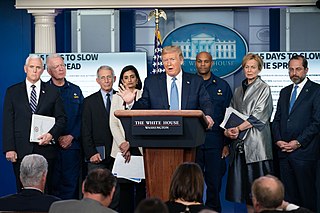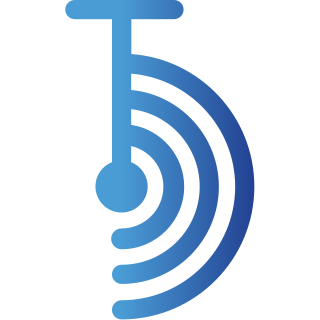
The Australian Strategic Policy Institute (ASPI) is a defence and strategic policy think tank based in Canberra, Australian Capital Territory, founded by the Australian government, and funded by the Australian Department of Defence along with overseas governments, and defence and technology companies.

The National Security Committee (NSC), also known as the National Security Committee of Cabinet, is the peak decision-making body for national security and major foreign policy matters in the Australian Government. It is a committee of the Cabinet of Australia, though decisions of the NSC do not require the endorsement of the Cabinet itself.
The COVID-19 pandemic in Australia was a part of the worldwide pandemic of the coronavirus disease 2019 caused by severe acute respiratory syndrome coronavirus 2. The first confirmed case in Australia was identified on 25 January 2020, in Victoria, when a man who had returned from Wuhan, Hubei Province, China, tested positive for the virus. As of 6 August 2022, Australia has reported over 11,350,000 cases and 19,265 deaths, with Victoria's 2020 second wave having the highest fatality rate per case.

The COVID-19 pandemic in California began earlier than in some other parts of the United States. Ten of the first 20 confirmed COVID-19 infections in the United States were detected in California, and the first infection was confirmed on January 26, 2020. All of the early confirmed cases were persons who had recently travelled to China, as testing was restricted to this group, but there were some other people infected by that point. A state of emergency was declared in the state on March 4, 2020. A mandatory statewide stay-at-home order was issued on March 19, 2020; it was ended on January 25, 2021. On April 6, 2021, the state announced plans to fully reopen the economy by June 15, 2021.

The White House Coronavirus Task Force was the United States Department of State task force during the Trump administration, the goal of the Task Force was to coordinate and oversee the administration's efforts to monitor, prevent, contain, and mitigate the spread of coronavirus disease 2019 (COVID-19). Also referred to as the President's Coronavirus Task Force, it was established on January 29, 2020, with Secretary of Health and Human Services Alex Azar as chair. On February 26, 2020, U.S. vice president Mike Pence was named to chair the task force, and Deborah Birx was named the response coordinator.

The COVID-19 pandemic has affected innumerable scientific and technical institutions globally, resulting in lower productivity in a number of fields and programs. However, the impact of the pandemic has also led to the opening of several new research funding lines for government agencies around the world.

The Biosecurity Act 2015 is an Act of the Parliament of Australia which manages biosecurity risks in Australia. It was enacted on 16 June 2015, after the Bill was passed with bipartisan support on 14 May 2015. It covers both agricultural and human medical biosecurity risks, including epidemics and pandemics, and is designed to contain and/or deal with any "diseases and pests that may cause harm to human, animal or plant health or the environment" in Australia.

Coronavirus Australia was an app released by the Australian Government designed to allow users to access information about the COVID-19 pandemic in Australia. The app was released by the Department of Health on 29 March 2020, and decommissioned two years later on 31 August 2022. Over its lifetime, the app was downloaded over a million times and was initially ranked first in the Apple App Store's "Health and Fitness" category. Due to the short development period of two weeks, the app initially served primarily as an aggregate of links to official government websites. Shortly after an update was released adding a voluntary "isolation registration" form that collected the location, name, age, mobile phone number, isolation start date, and various other details about users who were self isolating.

BlueTrace is an open-source application protocol that facilitates digital contact tracing of users to stem the spread of the COVID-19 pandemic. Initially developed by the Singaporean Government, BlueTrace powers the contact tracing for the TraceTogether app. Australia and the United Arab Emirates have already adopted the protocol in their gov apps, and other countries were considering BlueTrace for adoption. A principle of the protocol is the preservation of privacy and health authority co-operation.

COVIDSafe was a digital contact tracing app released by the Australian Government on 26 April 2020 to help combat the ongoing COVID-19 pandemic. The app was intended to augment traditional contact tracing by automatically tracking encounters between users and later allowing a state or territory health authority to warn a user they have come within 1.5 metres with an infected person for 15 minutes or more. To achieve this, it used the BlueTrace and Herald protocol, originally developed by the Singaporean Government and VMWare respectively, to passively collect an anonymised registry of near contacts. The efficacy of the app was questioned over its lifetime, ultimately identifying just 2 confirmed cases by the time it was decommissioned on 16 August 2022.
The Digital Transformation Agency (DTA) is an executive agency within the Australian Government’s Finance portfolio which supports the digital transformation of government services. Since 1 July 2022 it has done this by:
The COVID-19 pandemic in New South Wales, Australia was part of the worldwide pandemic of the coronavirus disease 2019 caused by severe acute respiratory syndrome coronavirus 2. The first confirmed case in New South Wales was identified on 19 January 2020 in Sydney where three travellers returning from Wuhan, Hubei, China, tested positive for the virus.
The COVID-19 pandemic in Victoria was part of the worldwide pandemic of the coronavirus disease 2019 caused by severe acute respiratory syndrome coronavirus 2. The first confirmed case in the state of Victoria, also the first in Australia, was identified as being on 19 January 2020, when a man from Wuhan arrived by air from Guandong, China. His test results on 25 January confirmed he had COVID-19.

The COVID-19 pandemic in Western Australia is part of the ongoing worldwide pandemic caused by severe acute respiratory syndrome coronavirus 2. Western Australia (WA) confirmed its first case of COVID-19 on 21 February 2020, and its first death on 1 March. On 15 March, premier Mark McGowan declared a state of emergency. On 24 March, Western Australia closed its borders to the rest of Australia, and on 1 April, the state implemented borders between regions in the state. By mid-April 2020, the state had eliminated community transmission of COVID-19, becoming one of the few places in the world to do so. There were only a handful of cases of community transmission in the state after mid-April, until late December 2021 when a tourist caused an outbreak that led to the cancelling of some New Year's Eve events, and the re-imposing of mask wearing rules in Perth and the Peel region.
The COVID-19 pandemic in South Australia is part of the ongoing worldwide pandemic of the coronavirus disease 2019 caused by severe acute respiratory syndrome coronavirus 2.
The COVID-19 pandemic in the Australian Capital Territory is part of the ongoing worldwide pandemic of the coronavirus disease 2019 caused by severe acute respiratory syndrome coronavirus 2. After one case of the delta variant in mid-August 2021, the Territory went into lockdown. By 26 September, the ACT had its first COVID-19 related death since mid-April 2020, nearly 18 months, followed by 3 more deaths in the first week of October 2021. 28 deaths during the outbreak since 12 August 2021 brought total deaths to 31, the most recent being on 8 February 2022.
This article documents the chronology and epidemiology of SARS-CoV-2, the virus which causes the coronavirus disease 2019 (COVID-19) and is responsible for the COVID-19 pandemic in Australia during 2020.
This article documents the chronology and epidemiology of SARS-CoV-2, the virus which causes the coronavirus disease 2019 (COVID-19) and is responsible for the COVID-19 pandemic in Australia during the first half of 2021.
This article documents the chronology and epidemiology of SARS-CoV-2, the virus which causes the coronavirus disease 2019 (COVID-19) and is responsible for the COVID-19 pandemic in Australia during the second half of 2021.
This article documents the chronology and epidemiology of SARS-CoV-2, the virus which causes the coronavirus disease 2019 (COVID-19) and is responsible for the COVID-19 pandemic in Australia during 2022.








